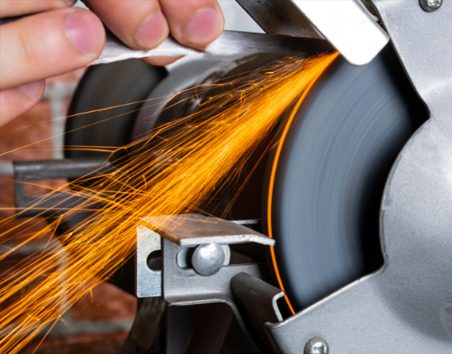A well-sharpened knife is a precise instrument that changes the cooking, creating, or cutting experience, not only a tool. Regular knife sharpening is necessary for safety, efficiency, and performance, whether you are a hunter, a chef, or a home cook. A dull knife increases the danger of slippage and damage by forcing extra pressure. Apart from safety, sharp knives provide smooth cuts with the least effort by improving your control and accuracy. Including appropriate knife sharpening in your maintenance schedule will help to prolong the life of your blades and improve your whole experience with them.
The Stone Sharpener: Modern Convenience Meets Traditional Precision
Of the various sharpening equipment at hand, the stone sharpener is a classic and very efficient choice. Trusted for ages, this instrument is also known as a sharpening stone or whetstone. It’s unequalled capacity to restore a blade’s edge by means of constant grinding and honing. A stone sharpener lets you precisely regulate the sharpening angle, whether it is made of natural or synthetic material, hence producing a beautifully polished blade suited to your cutting requirements. Although current electric sharpeners are fast, they can lack the control and refinement of a good stone sharpener.
Choosing the Correct Type of Stone Sharpener for Your Blade
Diving into knife sharpening requires choosing the appropriate kind of stone sharpener. The three main types are diamond stones, water stones, and oil stones. Durable oil stones offer a consistent grind, perfect for high-carbon steel blades. Chefs love water stones as they are quick and simple to clean. Diamond stones can handle even the most difficult blade materials and provide a quick sharpening procedure. Every kind has certain benefits, but they all have one purpose: to restore the sharp edge your knife merits.
Gradually, Stone Sharpener Knife Sharpening
Preparation starts with efficient knife sharpening. First, fasten your stone sharpener to a non-slip surface. Soak a water stone for 5 to 10 minutes before use. Your knife should be at a constant angle—usually 15 to 20 degrees—and you should gently move the blade across the stone from heel to tip. Do this motion on one side many times; then, switch. To hone the edge, use consistent pressure and end with lighter strokes. Some stones have a fine side for honing and a coarse side for reshaping dull blades. Regular practice of this method guarantees long-lasting sharpness and blade integrity.
Keeping Your Stone Sharpener for Best Performance
Your stone sharpener also needs upkeep, just as your knife does. Cleaning the surface often stops metal filings from blocking its pores, hence lowering its efficacy. Scrubbing with a brush and suitable fluid maintains water and oil stones in peak condition. Lapping the stone with a levelling tool or coarse sandpaper helps to maintain a flat surface, absolutely for uniform knife sharpening. A well-kept stone sharpener guarantees consistent outcomes and increases the lifetime of the instrument for many years.
Advantages of Regular Knife Sharpening Using a Stone Sharpener
Regular knife sharpening helps to maintain your blade in top shape and increases your kitchen or workshop productivity. A sharp knife cuts down on preparation time, improves dish presentation, and lessens weariness. Furthermore, a stone sharpener offers an affordable, environmentally responsible substitute for regular blade changes or electric sharpeners. This approach becomes both contemplative and gratifying with some experience. A stone sharpener also helps you to connect more deeply with your tools, a respect for artistry frequently lacking in the quick world of today.
Conclusion
The craft of knife sharpening with a stone sharpener is still a tribute to legacy, expertise, and durable quality in a society full of throwaway devices. Mastering the use of a stone sharpener is a useful and powerful tool whether you are recovering an heirloom knife or maintaining your daily kitchen blades. Every stage of the sharpening process takes you closer to optimal performance, from technique to tool maintenance. To find professional knife sharpening services and tools, further resources, advice, or to browse, go to nellacut.com.

